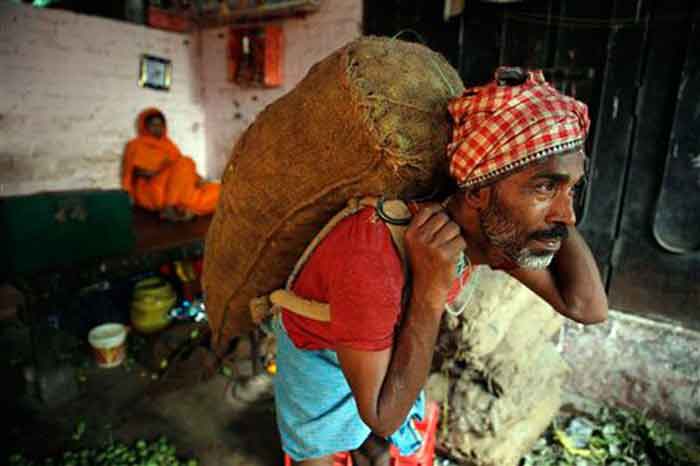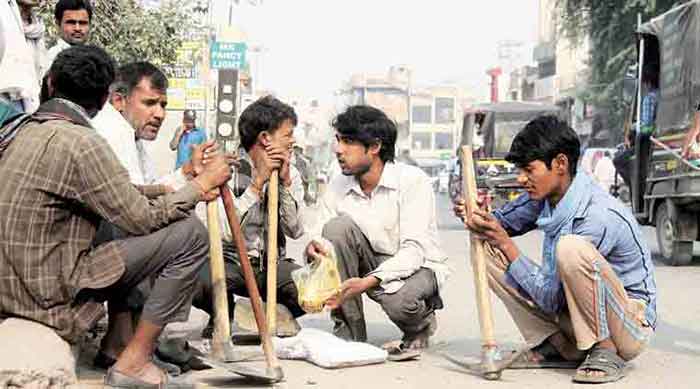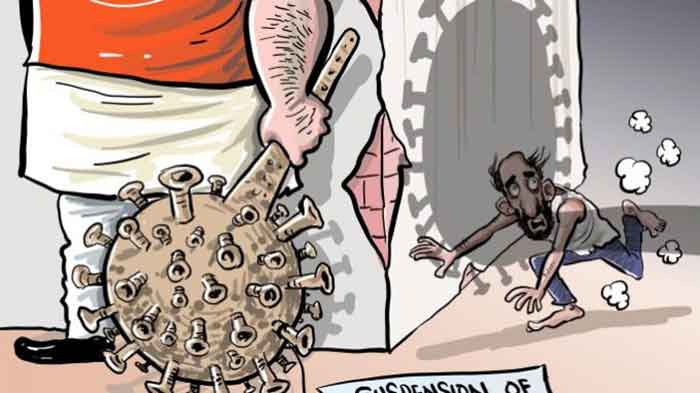
I
Through an ordinance on May 6, 2020 the Uttar Pradesh government exempted all factories and manufacturing establishments from prominent labour laws for the next three years. Titled temporary, the stipulations of an already undefined ‘labour law’ mean there is more scope of exploitation in its absence. The consequences of the exemption would mean a frozen minimum wage for three years, a working day of 12 hours, exemption from overtime pay, arbitrary termination becomes possible and no protection from working conditions jeopardizing safety and security of the workers. Industries have been exempted from accountability to all but four existing laws. The Madhya Pradesh government followed suit while Gujarat and Rajasthan also allowed for some exemptions. This distinctly suggests that the burden of reviving the economy is not on government spending, it is not on private taxation but on parasitically leeching the labour power of a worker’s exigency to survive. It was not that the proletariat was ever secure but that now the proletariat is being replaced by a concatenation of a precariat reality.
In Marx and Marxist literature, the proletariat has always been marked by a potentiality of becoming a class – a unit organised in struggle against oppressive conditions. Though unified by common economic conditions, they are isolated from each other due to their mode of production and hence are unable to organize and represent. The proletariat is the sleeping giant which must be awakened through class consciousness. This has been the method of the Left to organize wage labour into an organized class struggle with common demands and traditional imagination of a good life. But outside of the proletariat, Marx had another category- the figure of the lumpen proletariat. Gerald Raunig claims the lumpen proletariat to be of dubious origins, a combination of the last remains of a pre-industrial era and a contemporary appearance of the industrialised city (Raunig and Derieg, 2010) . These were the vagabonds, pickpockets, tricksters, beggars, pimps, brothel keepers, released prisoners or as Marx wrote – “scum, offal, refuse of all classes.” Unable to equate them with a “lower class”, the precariat is the successor of this diffused lumpen proletariat. The role of the proletariat is disappearing and in its place a multitude of precariat has come to form.
The precariat in the Industrial supply chain in India was a presence way before the pandemic crisis revealed the systemic injustice within the industry. Through a series of labour reforms, the permanent worker gave way to the contract worker which has now been replaced by faux developmental schemes of trainees and apprenticeships. In an article published in The Hindu, P.V. Srividya describes this gradual cementing of precarity. With growing leverage of in-house industrial training and skill development schemes, the presence of non-permanent and rotational workforce has increased immensely with little cost to the company. The industry does not absorb them as “confirmed” employees, they get paid in cash and with no liability to the company they are not owed accident insurance (Srividya, 2020). Many of them from part of the shadow economy, with their name absent from employee rolls receiving the little of the relief being provided by State governments also became difficult.
It is impossible to not be aware of your precarity in neo-liberal society, Lauren Berlant writes in Cruel Optimism. Whether it is the stifled aspiration due to social discrimination or desertion by the welfare state, what keeps from achieving the “good life” is known to an individual and a community (Berlant, 2012). The floor labour in the factory are aware of their temporariness, they have watched their seniors live and never come out of cyclical instability. Which is why most discourse of the brahmanical Left preserved in awakening consciousness continues to fail. It reconfirms that life can be made stable within the factory but it does not promise the good life outside of it, the desire of political richness, the freedom to experiment, the eagerness to be a rockstar, to be ambitious. That the wage labour is sinking out of the role of the proletariat should give the idealogues an indication to destroy the old saviour’s paradigm.
II
On the social media platform Twitter, an Indian journalist made popular the hashtag #metoomigrant. Her story like that of many long-term Indian migrants moving to the capital city is that of an ambitious upward mobility. What it does not acknowledge, her one line tale that is, is the interconnection of abandonment by law, a prevalent despotism of caste system and, a community rigidly excluded through documentation, which gives the migrant wage labour their ‘identity as migrant’.
The responses on her tweet though are a conversation on morality of empathy. Her critics call out her appropriation of an identity with terms such as starvation, hunger and poor being repeated frequently to describe the migrant. The debate now shifts to the logic of being recognized as a migrant, even when it is apparent that the constant refusal to absorb those dependent on seasonal work is the reason that the term migrant is being used easily to describe a population which moves through one skilled job to another. It is not a consensual identity which the civil society and the discussants have decided to defend. There is a disturbing absence of the knowledge of the structural violence which made the migrant labour precariat even before the pandemic provided the evidence.
Srividya explains how it is to the industry’s advantage to keep the workers at limited skills and in a cyclical state of temporary unskilled employment which is also why the contractors seek out a migrant workforce for their pliancy in an alien workspace. Essentially what the comment section was defending as a migrant was an identity created by an industrialisation which pushed them out of their homes, disregarded the knowledge of their lifestyles and history, made them an anonymous entity in the city all the while keeping in place the vulnerability of their caste interaction with the hierarchised system.
What is interesting to note is where the compulsion to become a migrant manifests form. It is not hard to remember Susan Sontag here while watching photographs of feet, unwarranted shots of young children, clothes, a mother being a mother on the open highway, tear drops, harsh lines, darkening of skin under the sun. The framed captions read out as needy, underprivileged, poor and downtrodden and we rush to protect these identities now that we have confirmed the reality of what it is to be a migrant labour. Sontag calls this an aesthetic consumerism, turning citizens into image junkies while being part of another person’s mortality, vulnerability and mutability (Sontag, 1977). The transference of this consumption is to become the framed, to imagine being the framed and then to pray to all your gods that you are thankful of not being the framed.
To assemble in the other’s pain has become easier with the liberties taken with extending solidarity. This liberal program earlier gave us tractions such as #notinmyname, #metoourbannaxal and #saveuniversities, all of which remained confident of breaching social differences and positions towards a prospective harmony. Eventually though distributing pain does not make a new solidarity if it fails to destroy the networks of the old one. If the older institutions have been the source of the problem. There is hardly any potential in saving it.
III
There is no desire to return to labourism and Fordist wage labour conditions. There is also no desire to return to the original community. The dichotomy of the individual and the community are altogether irrelevant now, Raunig writes. The community that awaits is the one strongly involved with the state in keeping conditions similar and maybe even worse for its precariat population. Within the period of the lock down due to the pandemic, the state apparatus has removed reservations and capped reservations for its SC/ST population in various levels of employment, the Forest Advisory Committee (FAC) continues to keep alive the proposed encroaching of protected areas by sanctioning the Dibang Hydropower Project in Arunachal Pradesh. Using the Unlawful Activities Prevention Act (UAPA) arrested the 27-year old Jamia Coordination Committee (JCC) member Safoora Zargar. The Indian state also refused to take provisions for releasing those imprisoned for smaller sentences in the overcrowded jail cells across the country and as of present it continues to grip Kashmir in a retrograde manner.
What is evident is that the community we return to as we open movement and interaction again is that which in the period of separation has come to detest the body of the precariat even more. They locked their homes and raised barricades in their localities and fervently clapped like puppets from their balconies. Will this community defend the wages? Will they defend the rights of the incarcerated, the abolition of war on citizens, on Kashmir?
It is not just the community but the manner in which economics is defined which reveals the symptomatic treatment. A former Chief Economist of the World Bank in a recent article (Things not to do in a pandemic, IE, May 15,2020) emphasises on sustaining the invisible hand of the economy. According to him the economy is an unbelievably complex organism where protecting the free market is the most essential. What he omits though is that the freedom of innovation of the free market is built on the foundation of making labour cheaper and, scattered in their socio-political position. This keeps the experimental nature of entrepreneurs flourishing because availability of skill labour kept in a state of desperation is surplus.
There have been cases of fighting back though. On March 30, workers of Instacart – a local grocery delivery service in the USA, went on strike to demand protective gear, $5 hazard pay per order, and an expansion of paid sick leave to high risk workers. While strike and walkouts have been common to workers movements, the method of organisation was different. Amazon workers and Whole Food workers built the momentum using free tools like Telegram, social media, and Google docs. Not having a Union the only mechanism to organize a labour movement without spending money has been using these free tools. They included the consumers also in their demand by asking them to not buy from these companies on May 1 (Gurley, 2020)
This is after all the reimagined general strike. There are immense possibilities in how we organise our anguish with an increasingly despotic world. There are several theoretical possibilities and yet praxis betrays the smooth well meaning intentions of theorists. The one question we should seek is how to build a solution which does not burden its livability on the backs of the most precarious.
References
Berlant, L., 2012. Cruel Optimism. Durham, NC: Duke University Press.
Gurley, L., 2020. Amazon, Whole Foods, Instacart Workers Organize a Historic Mass Strike. Motherboard, Tech by VICE, [online] Available at: <https://www.vice.com/en_us/article/n7j8zw/amazon-whole-foods-instacart-workers-organize-a-historic-mass-strike>
Raunig, G. and Derieg, A., 2010. A Thousand Machines. Los Angeles: Semiotext(e), pp.99-101.
Sontag, S., 1977. On Photography. New York: Farrar, Straus and Giroux.
Srividya, P., 2020. The precariat in the time of the pandemic. The Hindu, [online] Available at: <https://www.thehindu.com/news/national/tamil-nadu/the-precariat-in-the-time-of-the-pandemic/article31507857.ece>
Niharika Singh is a Political Science Research Scholar with the University of Delhi, India
SIGN UP FOR COUNTERCURRENTS DAILY NEWS LETTER

















































